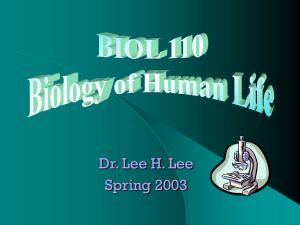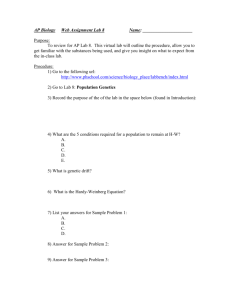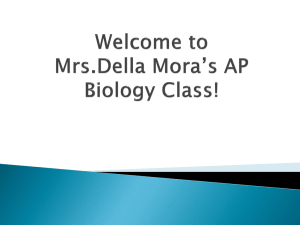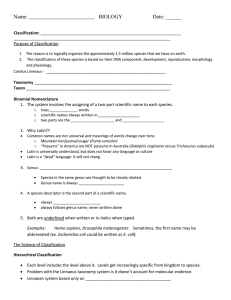07_07 07_07_short
advertisement
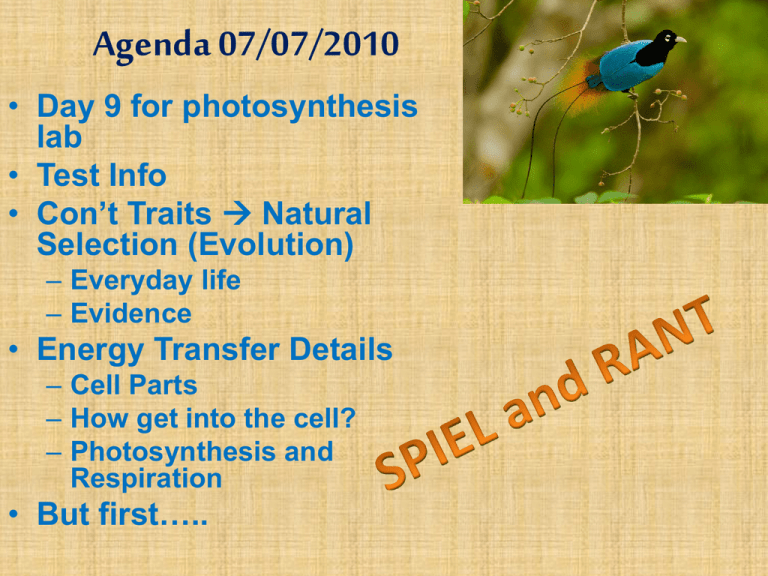
Agenda 07/07/2010 • Day 9 for photosynthesis lab • Test Info • Con’t Traits Natural Selection (Evolution) – Everyday life – Evidence • Energy Transfer Details – Cell Parts – How get into the cell? – Photosynthesis and Respiration • But first….. Study Guide for Test Friday, 07/09/2010 • • • • • • • Ecology Evolution Genetics Cells Scientific Inquiry Writing Writing Thoughts Multiple Choice! I will be grading the following as you are taking the test: 1. Safety “Quiz” 2. Notebook – looking for notes on specific days 3. Writing example 4. Sketches 5. Vocab Ring Example for Diversity and Natural Selection Biology Book Pages: •434 •435 •436 • How is Snail population diverse? How “help” population? • How is the moth population diverse? How “help” population? • What if either population did not have diversity? How does these example show evolution? • Evolution: Change over time • The moth populations changed (Natural Selection0 – Requirements: time, big/diverse population, more born then live – Selection Factors: Predation • Does Evolution affect your life? How does Evolution affect your everyday life? • Watch movie to find out! • Resistant Populations – Microbes evolve faster then our technology – Sick take medicine feel better so stop but only killed weak strong still in you which you pass on to someone else they take medicine stop – Lets sketch it out! Evidence for Evolution • Darwin, Biology book p. 419: – Embryology – Comparative Anatomy – Classification – Biogeography – Paleontology (fossils) • Today: – Above – DNA – Biochemistry sources • http://im.in.com/media/download/wallpapers/2009/Dec/nimo_420x315.jpg • http://www.google.com/imgres?imgurl=http://celebritygeckos.com/Portals/28/Genetics/Genetics/basicpunnetsquare.JPG& imgrefurl=http://celebritygeckos.com/Genetics/tabid/522/Default.aspx&usg=__vPL_U0niS850y2ni9NOoNp7KSK4=&h=500& w=500&sz=18&hl=en&start=44&um=1&itbs=1&tbnid=e54pOgLZQ7oSxM:&tbnh=130&tbnw=130&prev=/images%3Fq%3Dbl ue%2Beye%2Bpunnett%2Bsquare%26start%3D40%26um%3D1%26hl%3Den%26safe%3Dactive%26sa%3DN%26rlz%3D1T4G GIT_enUS326US351%26ndsp%3D20%26tbs%3Disch:1 • http://www.astronoo.com/images/images_articles/phalenesDuBouleau_315.jpg • http://www.shodor.org/succeedhi/succeedhi/PepperedMoths/moth_fig1.gif Energy Transfer – DETAILS! • We will be Learning by – taking notes – drawing a picture – a couple activities • What you need: – – – – – Notes Large sheet of paper (maybe 2) Pencil and Pen Colored Pencils NO MARKERS (writing on back, so don’t want to bleed through!) – Lifeworks book and Biology book Lets Review… • All Energy comes from the • process called energy into capture the sun’s energy in a and change this . • get producers or other • and by eating need to break into energy they can use. This happens in a process called . • Both of these processes take place in the Types of Cells Eukaryotic Cell Organelles and Functions All • • • • • Only in Autotrophs • • • Autotroph Energy through: Only in Heterotroph • Heterotroph Energy through: Cells and Energy Transfer – Biology book Types of Cells define: •Prokaryote •Eukaryote Sketch out a plant and animal cell (p.221) Both of these are examples of Eukaryotic Cells as they have membrane bound organelles Heterotroph: • Cell Membrane • Nucleus • Cytoplasm • Ribosomes • Mitochondria • Vacuoles (many/small) Autotroph: • Cell Membrane • Nucleus • Cytoplasm • Ribosomes • Mitochondria • Cholorplast • Cell Wall • Large Vacuole Sources • http://www.timlaman.com/
